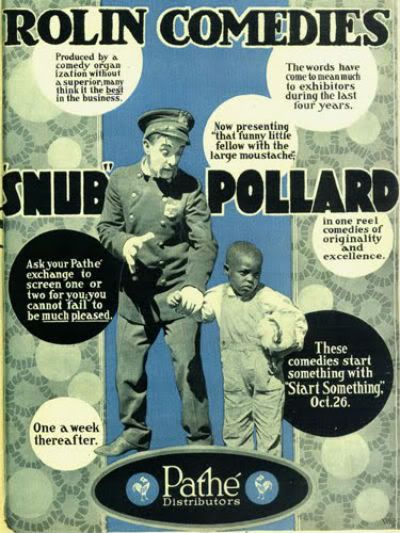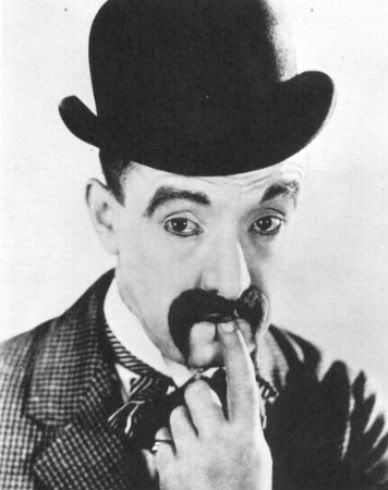
RATING: ½ out of ****
PLOT: A jealous ex-suitor, scorned over losing the girl (Marie Mosquini) to Snub Pollard, fills the groom’s head with stories about how the house the couple has purchased is haunted. He also fills the mansion with all manner of trickery to back up his claim, including a parrot to provide disembodied voices, a cat to get stuck on fly paper and make weird noises, and a disguise sure to terrify anyone. Not that Snub needs any help – his own scaredy-cat imagination fills in plenty of the blanks for him!
REVIEW: Snub Pollard is one of those silent comedians who toiled for so long and appeared in so many films of varying quality that just by longevity he’s bound to be recognized by those that may not know him by name. His visual notoriety was helped along by the fact that he continued to be employed in talkies (particularly when “an old silent clown type” was needed as he was utilized in “Singing in the Rain,” “Limelight” and “The Errand Boy;” he also turns up unexpectedly in such classics as “Miracle on 34h Street” and “The Day the Earth Stood Still”) and appeared in scores of TV shows (including such popular westerns as “Gunsmoke” and “Bonanza”) but his biggest claim to fame is surely his classic short, “It’s a Gift” (1923), not to be confused with the classic W.C. Fields feature film of the same title).
In that short, Snub plays an eccentric inventor of crazy gadgets. The two main set-pieces of the film are Snub starting his day in his bedroom full of Rube Goldberg-esue pull-string conveniences (when he pulls strings chickens lay eggs that are deposited into frying pans, the bed sheets fly off the mattress to become window drapes, the bed becomes a bookcase) followed by Snub setting out on the road in his special magnet car (the bullet-shaped canoe-like car moves whenever Snub holds a giant horseshoe magnet in the air, being pulled along by the magnetic attraction of passing vehicles).
Snub’s magnet car scenes have taken their place alongside Harold Lloyd dangling from the giant clock in “Safety Last” and Charlie Chaplin stuck in the giant machine gears in “Modern Times” as an iconic image that speaks to the age of innovation and industrialization.
The last scene, involving a fuel that proves to be just too explosive doesn’t match what came before but is rescued by a shot of Snub pushing a button in his car to reveal wings, allowing him to safely fly away from the angry mob.
Unfortunately, nothing can help Snub fly safely away from the angry viewers of “Grab the Ghost.” To be fair, Snub is in there pitching but the material is just so ill-conceived and nonsensical (and not in the fun way that such scenes often play in horror-comedies) that the audience is left scratching their heads at what they’ve just seen. And thankful that it was only one reel (nine minutes)!
The opening scene of “Grab the Ghost” is reminiscent of many Keaton, Lloyd and Charley Chase silents. We get a post-wedding scene (participants filing out of church) with a spurned groom (although usually with the other comics they’re the ones that are spurned until the final reel, when they reveal their rivals to be heels and themselves as virtuous). The disgruntled “ex” vows to a friend that he’ll “get even” with Snub. When Snub misses the wedding limo and chases after it, bumbling and tumbling all the way its definite shades of Keaton and Lloyd.
Snub had all the tools of the great silent clowns. For starters, he had a “signature look.” Snub’s look was defined by his walrus mustache. He also had a very expressive face – he did a lot with his eyes, his cheeks, his nose and his mouth. Last but not least, he was adept at acrobatics – he could flip and flail with the best of them.
This is particularly noticeable when Snub arrives home. When the servant boy lobs a shoe at Snub’s head, his reaction – facial expression and body language – are so animated and fluid they suggest a cartoon character. The effect is complete when Snub takes the shoe, winds up in exaggerated fashion and sends it back to the boy (for his part, the boy does a wonderful delayed fall after getting hit, then quickly gets back up).
In fact, if not for Snub and his master clowning, this short would receive no stars at all from me. All the stars (well, half a star) go to Snub. I wish I could even bump it up from a half to a full star but unfortunately the slipshod story and direction nearly dismantle Snub’s hard work entirely.
As this is a one-reeler running just nine minutes it’s not long before the “scare” material is introduced. Unfortunately, it’s weak material indeed. The rival has enlisted some folks to help scare the pants off of Snub. Snub and his bride have moved into a house that his rival claims is “haunted” – “there’s a ghost in every room and six spooks camping out on the roof,” he warns.
The rival spins a tale of a man who murdered his wife, which Snub vividly imagines. Meanwhile, a parrot beneath the table is screaming out words to underscore the terror of the story. Snub does a great extended scare take with his hat wobbling everywhere… but as great as it is its pretty much as good as this short ever gets – there’s nothing much left to build on after the short reaches this early peak. Sure, Snub goes to town – his hands go aflutter, his ears wiggle, his eyes bug out, his hat wavers and wobbles atop his head, he shakes and he shivers and he is very funny doing it all but it’s all in the service of scares that aren’t really all that scary… especially compared to other silent horror-comedies of the decade from Buster Keaton, Harold Lloyd, Our Gang and Laurel & Hardy. All the more puzzling because “Grab the Ghost” was produced by Hal Roach Studios, who brought us those Our Gang, Lloyd and Laurel & Hardy shorts!

The problem with the film is the same one that fellow silent clown Harry Langdon faced in his talkie short with Una Merkel, “To Heir is Human.” In short, it tries to go for non-typical scares. Whether this was a case of trying to be “novel” or just due to budget constraints we don’t know, but most of us come looking not only for the familiar tropes and trappings we’ve come to expect in a horror comedy, but that they be recognizable as such, too.
A great case in point is an old bearded man character that walks into scenes as if he’s a somnambulist. He’s weird to be sure but the effect on screen is underwhelming – the character is not all that scary as he just looks like a man. Other lackluster fright attempts include a sheet that falls on a mannequin – it’s meant to suggest a ghost and that’s how Snub takes it but the sheet falls over the statue’s head with the bronze arm sticking out so it just looks like a statue wearing a toga instead of a ghost! When the scares aren’t underwhelming they’re inexplicable: hearing a commotion outside the bedroom, Snub’s wife throws a sheet over her head in an attempt to hide (of course Snub walks in and thinks she’s a ghost). This gag would work with a well-established character like Stan Laurel who’s prone to do absurdist things, but why would Snub’s wife ever think she can “hide” under a sheet?
There are additional scenes of the black servants being scared. They’re apropos to nothing really – maybe the rival thought that if he could scare the servants in the process of scaring Snub the fear of the servants would help sell the ruse even more. The scenes simply aren’t either scary or funny though; just flat and uninteresting at best and uncomfortable from a stereotype standpoint at worst.
Nothing of any real consequence happens in this short when suddenly the final moments are taken up by a gaggle of Keystone-esque cops that rush into the house, up the stairs, into the bedroom, back down the stairs and back up the stairs. Repeatedly. Especially after Snub gets stuck under a sheet (now everyone thinks he’s a ghost).
It all grinds to a stultifying halt as the rival arrives to “save the day” only to have the fake beard and wig from his somnambulist get-up fall out of his vest, the cops already conveniently there to take him away.
The idea of only seeing ghosts while under the influence is posed twice by the short. In an earlier scene, Snub’s wife makes a crack about there being less ghost sightings since prohibition. This idea is repeated by Snub’s wife in the short’s finale, as she asks him, “What’s the idea – have you been smoking cubebs again?”
I don’t know about Snub, but maybe the writers of this short were!
SPOTTED IN THE CAST: Maybe some astute readers out there who have seen the film can clue me in on any notable supporting players because only Snub and his bride are credited.
BEST GAGS: It’s redundant to say so but Snub is the whole show here. Truthfully there are no real gags of note here, just Snub’s expert clowning as he reacts to all the non-scares.
Despite the above, it is worth pointing out probably the one notable aspect of the short: when the parrot under the table yells “HELP!” and “MURDER!” and “POLICE!” we see the words share the screen with the parrot (not as separate title cards) as if they are captions in a comic book. Not a gag per se but easily the most unique element in this short.
BEST "DIALOGUE": One title card stands out, and the line is spoken by Snub’s wife: “I was foolish to be scared. Nobody sees ghosts – not since prohibition.”
FURTHER READING: The seminal work on silent film comedy is Walter Kerr’s “The Silent Clowns.” Every film fan’s library should have it. Currently out-of-print and commanding collectible prices in pristine condition, you can find some lower-priced used copies when you click here.
BUY THE FILM: If you insist. Alpha Video, purveyors of public domain films have released a DVD called “Silent Slapstick Comedy Parade” featuring Snub’s “Grab the Ghost” along with entries from Ben Turpin, Paul Parrot and others, that you can purchase when you click here.
WATCH THE FILM: … or don’t! I couldn’t find a clip of this film online but in retrospect it’s just as well. I encourage you to search for (and enjoy) Snub’s masterpiece, “It’s a Gift” instead.


No comments:
Post a Comment